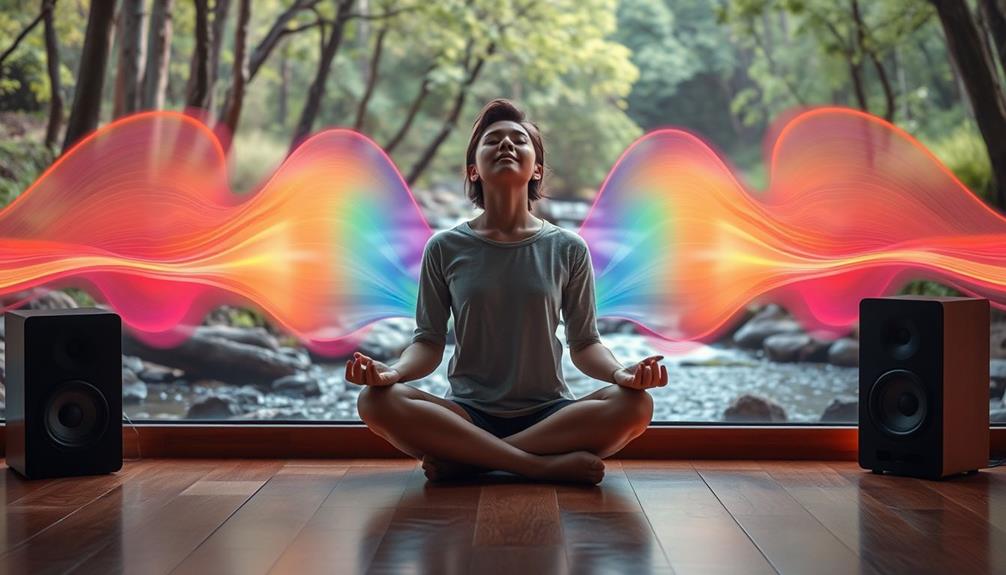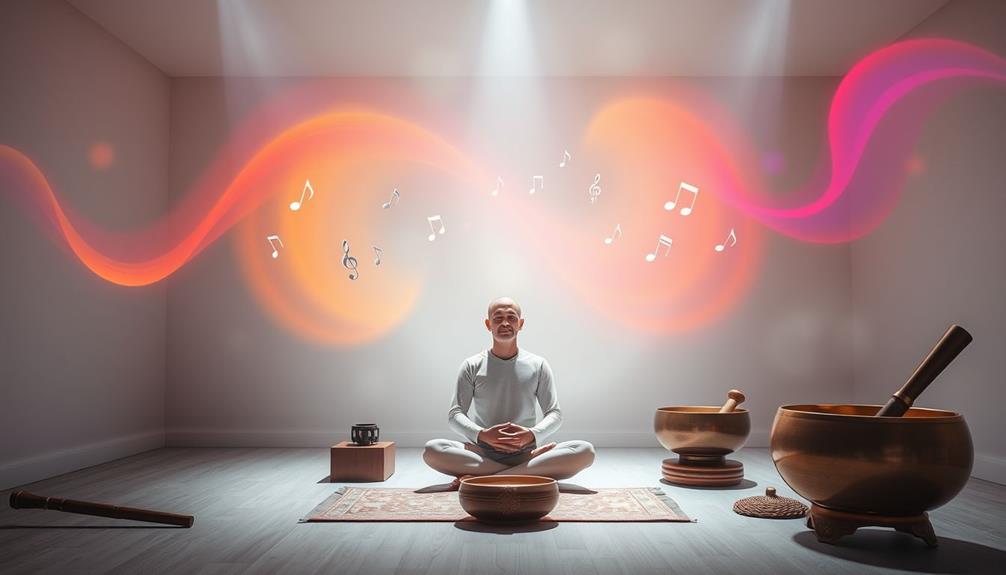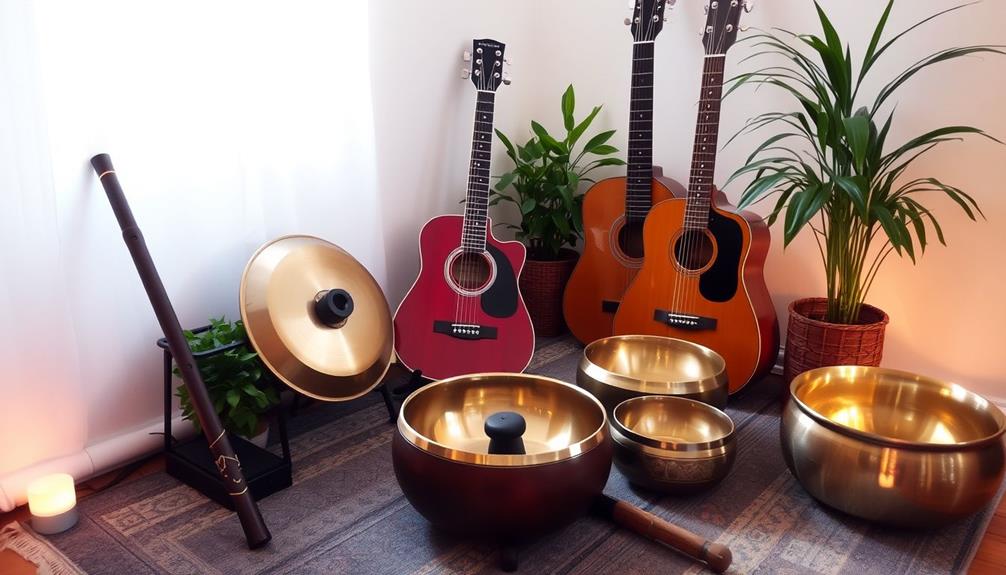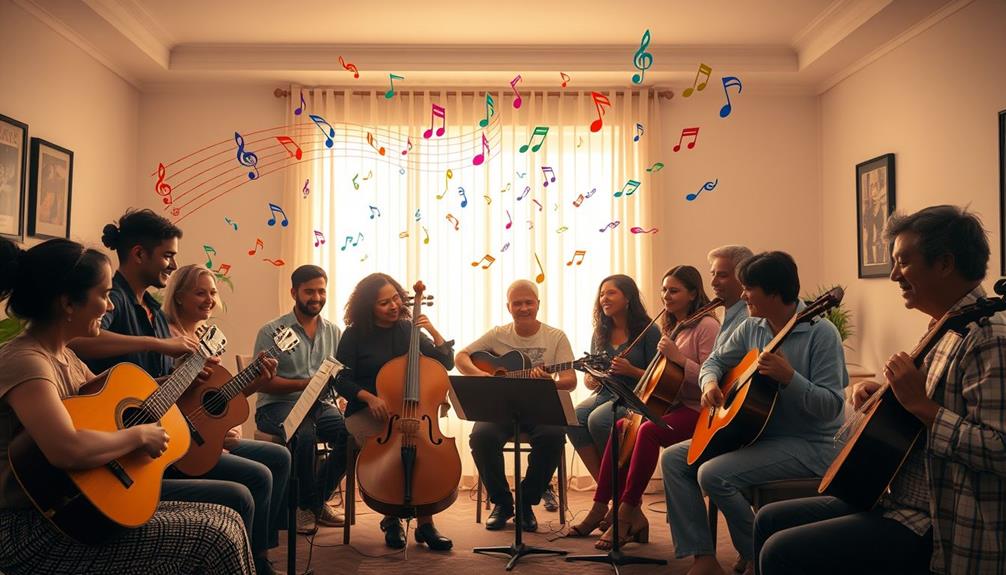You can enhance your mindfulness practice by incorporating music in thoughtful ways. Start by creating a personalized playlist filled with calming and emotionally resonant tracks. Engage in focused listening to deepen your awareness of bodily sensations and feelings. Aim for a distraction-free space where you can fully immerse yourself in the sounds. Experiment with different genres and tempos to find what resonates most with you. This practice not only reduces stress but also enriches your emotional processing. As you explore the connection between music and mindfulness, you'll uncover even more techniques to elevate your experience.
Key Takeaways
- Music enhances emotional connection during mindfulness practices, fostering emotional catharsis and deeper self-awareness.
- Creating a mindful playlist with diverse genres can improve focus and emotional engagement during mindfulness exercises.
- Mindful listening techniques, such as focusing on instrumental music, can enhance present moment awareness and emotional processing.
- Regular engagement with music lowers cortisol levels, effectively reducing stress and promoting relaxation.
- Incorporating tools like a feelings wheel can enhance emotional understanding and self-reflection during music listening sessions.
Defining Mindfulness
Mindfulness is fundamentally about staying present and aware in each moment. It's a practice that involves maintaining a moment-by-moment awareness of your thoughts, feelings, bodily sensations, and the environment around you. By recognizing and accepting your thoughts and feelings without judgment, you foster a sense of clarity and calm. This process allows you to observe your inner experiences and outer surroundings, promoting deeper awareness.
Engaging in mindfulness can also enhance your ability to achieve goals, as fun in goal achievement encourages motivation and creativity in your practice.
You can cultivate mindfulness through various techniques, such as meditation, breathing exercises, or even by engaging fully in daily activities. Each practice helps you anchor your awareness in the present, allowing you to break free from the distractions of past regrets or future anxieties.
Regular mindfulness practice is linked to reduced stress, anxiety, and depression, while also enhancing attention and emotional regulation.
Moreover, studies suggest that mindfulness can improve your overall well-being and resilience. By breaking negative thought cycles, you encourage a more positive outlook on life.
Ultimately, embracing mindfulness empowers you to live more fully in the present, enriching your experiences and enhancing your quality of life.
The Role of Music

Music plays an essential role in your mindfulness practice by creating an emotional connection that enhances your awareness.
By incorporating elements of AI in Music Creation, you can explore new sounds and compositions that resonate with your mindfulness journey.
When you intentionally listen, you can deepen your experience and connect with your feelings on a more profound level.
Incorporating sound into your routines not only promotes relaxation but also strengthens your ability to stay present.
Emotional Connection Through Music
Few experiences rival the emotional impact of a well-chosen piece of music, as it can evoke feelings that resonate deeply within you. This emotional connection enhances your mindfulness practice, allowing you to engage with your feelings on a profound level.
When you intentionally listen to music, you create space for emotional catharsis, helping you process and express your emotions more effectively. Incorporating elements of music production basics, such as understanding loops and using specific tools, can further enhance the music's ability to connect with your emotions.
Studies show that music activates brain regions linked to emotion and cognition, enriching your experience during mindfulness exercises. By incorporating music into your practice, you can facilitate emotional release, promoting a sense of calm that enhances your overall emotional well-being.
Mindful listening becomes a tool for exploration, guiding you through personal sensations and memories. As you immerse yourself in music, pay attention to how it makes you feel. Reflect on the emotions that arise and the memories it stirs.
This deeper emotional connection allows you to gain insights into your current state and fosters a greater understanding of yourself. Ultimately, using music in your mindfulness practice can transform your emotional landscape, offering both healing and clarity.
Music's Impact on Awareness
Engaging with music not only deepens emotional connections but also heightens your awareness of the present moment. When you listen mindfully, you're activating multiple brain regions involved in emotion, cognition, and sensation. This heightened awareness fosters a deeper connection to your emotions and thoughts, setting mindful listening apart from casual experiences.
Incorporating elements like essential oils for relaxation during your listening sessions can further enhance your mindfulness practice, creating a multisensory experience that promotes tranquility.
Specific songs can evoke unique emotional responses and trigger memories, allowing you to explore your inner experiences through music. By sitting with music, you create an opportunity for emotional processing and reflection, leading to greater self-awareness and insight. As you focus on the sounds and lyrics, you become more attuned to your feelings, enhancing your overall mindfulness practice.
Moreover, repeated listening to the same piece can reveal different emotional layers and insights over time. Each session offers a fresh perspective, encouraging you to engage more fully with your emotions and thoughts. This continual exploration can greatly deepen your awareness, making music an invaluable tool in your mindfulness journey.
Enhancing Mindfulness With Sound
Sound has a unique ability to anchor you in the present moment, making it an essential element in enhancing mindfulness. When you engage in mindful listening to music, you focus your attention, allowing emotions and sensations to surface. This practice fosters deeper self-awareness and helps you process your feelings more effectively.
Incorporating music into your mindfulness routines can also improve decision-making and social skills, much like engaging in fun personality quizzes for kids.
Incorporating music into your mindfulness routines can considerably lower cortisol levels, which helps reduce stress and promotes relaxation. This creates a more balanced mental state, essential for overall well-being.
Whether you're listening or playing an instrument, active engagement with music encourages a non-judgmental awareness of your thoughts and feelings, aiding in emotional regulation.
Listening to the same piece repeatedly can also reveal different emotional layers, enriching your mindfulness experience. Each session offers new insights and depths, making your journey of emotional exploration more profound.
Benefits of Music in Practice

Music can greatly enhance your emotional connection during mindfulness practice, making it easier to process feelings.
Incorporating elements of nature in your music selection can further amplify this experience, creating a serene backdrop that fosters tranquility natural materials.
It also serves as an effective stress reduction technique, helping you lower anxiety and cultivate a sense of calm.
Emotional Connection Enhancement
Incorporating music into your mindfulness practice can greatly enhance your emotional connection to the experience. Music can help you dive deeper into your feelings, revealing layers of emotion you might not have noticed before. By engaging with music mindfully, you foster emotional insights, which enrich your overall mindfulness journey.
Here's how different types of music can impact your emotional state:
| Type of Music | Emotional Impact | Mindfulness Benefit |
|---|---|---|
| Upbeat Tunes | Boosts mood and energy | Encourages positive thinking |
| Calming Melodies | Reduces anxiety and promotes relaxation | Aids in emotional regulation |
| Personal Favorites | Triggers memories and introspection | Fosters deeper emotional connection |
Utilizing personalized playlists tailored to specific emotional states can also promote exploration and engagement during your mindfulness sessions. When you allow music to guide your practice, you create an environment where emotional connection enhancement becomes possible, making your experience richer and more meaningful. This mindful integration of music not only aids in emotional processing but also helps in coping with challenges like anxiety and depression. Let music be your companion on this journey.
Stress Reduction Techniques
Harnessing the power of melodies can be a game-changer in your stress reduction toolkit. Music offers an effective way to lower cortisol levels, the hormone linked to stress, promoting relaxation and reducing anxiety.
When you listen to music mindfully, you enhance your emotional awareness, allowing you to process and release stress through emotional expression. In addition, engaging with music can enhance your overall well-being, as it drives lifelong learning and personal development, fostering the benefits of curiosity in the process.
Moreover, music's rhythmic qualities can sync with your breathing patterns, creating a calming effect that aids in stress reduction. Studies show that music therapy considerably decreases symptoms of anxiety and depression, which can lead to improved overall mental health.
To integrate these stress reduction techniques into your daily life, consider creating personalized playlists filled with soothing or uplifting tracks. This self-care strategy can serve as a powerful tool to manage stress and promote well-being.
Whether you're winding down after a long day or seeking motivation during a tough moment, the right music can transform your mindset. By incorporating music into your mindfulness practice, you'll not only find relief from stress but also cultivate a deeper appreciation for the emotional power of sound.
Deepening Present Moment Awareness
The power of sound can significantly deepen your present moment awareness, inviting you to fully engage with your surroundings. When you practice mindful listening to music, you tap into a rich sensory experience that can evoke emotional responses, helping you immerse yourself in the current moment.
This engagement fosters a heightened state of awareness, allowing you to explore your thoughts and feelings more deeply. Incorporating mindfulness practices, such as yoga for back pain management, can further enhance your ability to connect with your body and emotions while engaging with music.
Research shows that mindful listening can lower cortisol levels, reducing stress and fostering a calmer mindset. By focusing intently on the melodies and rhythms, you create a space for emotional processing and self-reflection, essential components for maneuvering daily life.
Incorporating music into your mindfulness practice encourages you to actively explore personal sensations, enhancing your connection to the here and now. Regularly engaging with music this way can improve your emotional regulation and coping strategies, equipping you to handle your feelings more effectively.
Creating a Mindful Playlist

When crafting a mindful playlist, focus on selecting songs that resonate with your emotions and enhance your experience. Emotional responses can greatly boost your mindfulness practices, so choose tracks that evoke positivity. You might also consider incorporating elements from functional beverages like mushroom coffee pods to enhance your overall sense of well-being during your practice.
Consider these tips as you create your playlist:
- Diverse Genres: Include a variety of musical genres and tempos to suit different moods and enhance your mindfulness practices.
- Instrumental vs. Lyrical: Aim for a balance between instrumental tracks, which promote deep focus, and lyrical songs that trigger memories and emotions.
- Manageable Length: Limit your playlist to about 10-15 songs. This keeps it manageable and allows for repeated engagement with each track, revealing deeper emotional insights.
- Cohesive Flow: Organize your songs to shift smoothly from calming tracks to more uplifting ones, creating a cohesive journey that aligns with your mindfulness journey.
Strategies for Mindful Listening

Engaging deeply with music can transform your listening experience into a powerful mindfulness practice. To start, consider immersing yourself in instrumental music. This way, you can focus solely on the sounds without the distraction of lyrics.
Exploring diverse genres of music, such as those found in best animated movies, can also enrich your experience. Find a distraction-free environment where you can truly connect with the music. Notice the various elements, such as the pace and different instrument sounds, without any interruptions.
As you listen, pay attention to your bodily sensations and emotional responses. This observation helps you develop a deeper self-awareness, enhancing your overall mindfulness practice. You might notice how certain melodies resonate with your feelings or even evoke memories.
Another effective strategy is to repeat listen to the same song. Each time, you may uncover different emotional layers, leading to a richer understanding of your personal feelings and experiences associated with the music.
This practice of mindfully listening not only connects you to the music but also fosters a greater understanding of yourself. By integrating these strategies into your routine, you'll find that practicing mindfulness through music can be both rewarding and transformative.
Emotional Connection Through Music

Often, music stirs emotions in ways that words alone can't capture. When you engage with music mindfully, you create an emotional connection through music that allows for deep reflection on your feelings and experiences. This process can lead to significant emotional insights. By intentionally listening to specific songs or melodies, you can explore the thoughts and sensations tied to them.
To enhance your emotional connection, consider the following techniques:
- Use a feelings wheel to identify and articulate your emotions while listening.
- Repeat songs to uncover different emotional layers and insights.
- Allow music to serve as a tool for emotional catharsis, helping you release pent-up feelings.
- Make time for reflective listening, transforming your experience into a mindfulness practice.
As you engage with music, you'll find that it promotes healing and emotional awareness. This practice not only fosters connection with your emotions but also helps you understand the nuances of your feelings better.
Embrace the power of music and watch how it enriches your mindfulness journey.
Music for Stress Reduction

Many people find that music not only deepens emotional connections but also serves as a powerful ally in reducing stress. Listening to calming, soothing music can greatly lower cortisol levels, the hormone linked to stress, which leads to an overall decrease in stress levels.
When you engage with instrumental or soft melodies, you'll notice a drop in your heart rate, promoting relaxation responses in your body.
Incorporating music for stress reduction into your mindfulness routine can be highly effective. Regular mindful listening has been shown to reduce anxiety symptoms and improve emotional regulation, making it an essential tool for managing stress.
To maximize these benefits, consider creating personalized playlists filled with soothing music that resonates with you. This auditory backdrop not only enhances your mindfulness practices but also provides comfort during challenging moments.
Research indicates that individuals who weave music into their mindfulness routines experience higher levels of relaxation and satisfaction during stress-reduction exercises.
Exercises for Mindfulness With Music

Explore the transformative power of music by incorporating it into your mindfulness practices. Engaging with music can deepen your awareness and enhance your emotional processing.
Here are some exercises to help you merge music and mindfulness effectively:
- Focused Listening: Identify a personally meaningful song and listen intently. Let the music evoke thoughts, feelings, and bodily sensations without distractions.
- Active Listening: Pay attention to various elements of the music—notice the instruments, volume shifts, and your emotional responses to deepen your connection to the present moment.
- Reflection: After listening, take a moment to assess your emotional state. Consider how the music influenced your mindfulness practice and what insights it provided.
- Feelings Wheel: Use a feelings wheel during or after your listening session to help articulate the emotions that arise. This promotes greater emotional awareness and understanding.
Community Engagement in Music

Engaging in local music events can really enhance your sense of community while fostering connections with others.
Participating in a community choir or attending cultural exchange opportunities allows you to experience diverse musical traditions firsthand.
These activities not only strengthen relationships but also promote a shared appreciation for music's role in our lives.
Local Music Events
Local music events play an essential role in fostering community engagement and enriching the cultural landscape. By participating in these events, you connect with others, celebrate local talent, and experience diverse musical expressions.
They provide a platform not just for musicians but also for the community to come together and share in the joy of music.
Here are some exciting local music events you can look forward to:
- Levine Music and CityDance Studios: The new Virginia Campus opening in July 2024 will enhance cultural opportunities.
- AAPI Heritage Month Events: Celebrate Asian American and Pacific Islander composers every May, raising awareness of their contributions to music.
- Misbin Family Memorial Chamber Music Competition: Supporting young artists in the DC area, this event showcases instrumental chamber music and creativity.
- Marlin-Engel Solo Competition: Established in 1980, this competition highlights individual talent through outstanding solo performances.
Engaging in these local music events not only enriches your life but also strengthens community ties, making the neighborhood a vibrant space for cultural exchange.
Community Choir Participation
Joining a community choir offers a unique way to deepen your connection with others while celebrating the joy of music. Through community choir participation, you'll engage with diverse individuals who share your passion for singing and collaboration. This shared interest fosters social cohesion, making it easier to form strong bonds during rehearsals and performances.
As you sing together, you'll not only enhance your musical skills but also experience personal growth that positively impacts your mental health. Research shows that group singing can lower stress levels and boost your mood by releasing endorphins.
You'll find that engaging in choir activities helps reduce feelings of isolation, increasing your sense of belonging in the community.
Moreover, community choirs often participate in local events, enriching cultural experiences and enhancing community engagement through music. This involvement not only brings joy to you but also to those around you, creating a ripple effect of positivity.
Cultural Exchange Opportunities
Cultural exchange opportunities in music create a vibrant tapestry of connections that enrich both individuals and communities. Engaging with diverse musical traditions fosters understanding and appreciation, enhancing your mindfulness practice.
By participating in local events, you not only immerse yourself in various cultural expressions but also contribute to a more cohesive society.
Here are some ways you can engage with cultural exchange opportunities in music:
- Attend celebrations like AAPI Heritage Month, where you can explore the contributions of Asian American and Pacific Islander composers.
- Participate in competitions like the Misbin Family Memorial Chamber Music Competition, which support young artists and celebrate creativity.
- Join performances in the Marlin-Engel Solo Competition, where you can showcase individual talent and acknowledge outstanding achievements.
- Support local concerts that promote social cohesion and encourage cultural exchange within your community.
Resources for Mindfulness and Music

When exploring resources for mindfulness and music, you'll find a variety of options that enhance your practice and well-being. Community events like Music & Meditation sessions at Orchestra Hall combine live performances with mindfulness practices, promoting relaxation and awareness. These experiences can help you connect deeper with both music and your inner self.
You might also consider the University of Minnesota's Bakken Center for Spirituality & Healing, which offers mindfulness classes that incorporate music. These classes focus on cultivating emotional and mental well-being, providing you with tools to navigate life's challenges.
Creating personalized playlists is another powerful resource. By selecting music that resonates with your emotions, you can facilitate deeper connections during your mindfulness exercises. Soft instrumental music is particularly effective, as it fosters a calming atmosphere conducive to emotional processing and relaxation.
Don't forget online platforms and social media; they're treasure troves for mindfulness and music resources. You can access guided sessions, insightful articles, and community updates to support your ongoing practice.
Frequently Asked Questions
How Can Music Be Used in Mindfulness?
You can use music to enhance mindfulness by actively listening to its nuances, creating personalized playlists that resonate with your emotions, and allowing the melodies to guide your thoughts, promoting relaxation and deeper emotional awareness.
How to Practice Meditation With Music?
To practice meditation with music, choose calming sounds, take deep breaths to start, and actively listen to each element. Reflect on your feelings afterward, and consider repeating pieces to deepen your experience over time.
How Do You Practice Mindfulness of Sound?
To practice mindfulness of sound, find a quiet space, close your eyes, and focus on the layers of sound around you. Breathe deeply, let distractions pass, and reflect on your emotional responses to the experience.
What Are the Benefits of Mindful Music?
Mindful music offers you stress relief, emotional awareness, and improved mental health. It lowers cortisol levels, enhances focus, and fosters emotional regulation, making it a powerful tool for coping with anxiety, depression, and everyday challenges.
Conclusion
Incorporating music into your mindfulness practice is like planting seeds in a garden of your mind; with care and attention, they can blossom into peace and clarity. Each note you listen to is a drop of water nourishing your spirit, guiding you back to the present moment. Embrace the harmonious dance between sound and silence as you cultivate your inner landscape. Remember, just as music flows, so too can your journey toward deeper mindfulness and connection. Incorporating music into your mindfulness practice not only enhances your ability to stay present, but it can also elevate your overall experience. Integrating music into yoga practice can create a powerful synergy, promoting a deeper sense of relaxation and concentration. Let the music become a supportive and grounding force as you flow through your yoga practice, complementing the movement of your body and the stillness of your mind.









